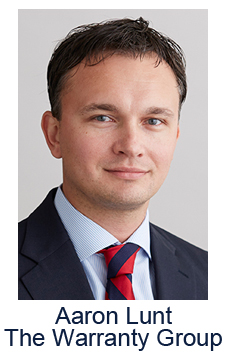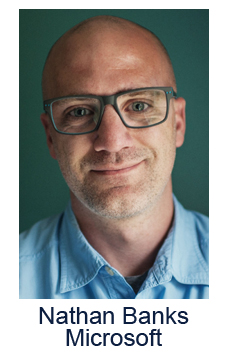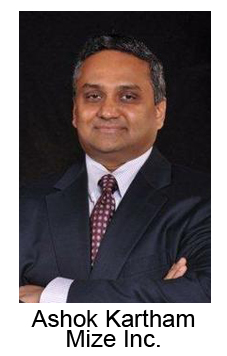February 15, 2018 |

|
ISSN 1550-9214 |
WCM Conference Preview, Part 1:The workshops are filling up, and travel plans are being made for the 14th edition of this annual warranty and service contract industry conference. The agenda this year is a mix of both returning favorites and new topics suggested by both presenters and attendees at past conferences.If you can believe it, the 14th annual Warranty Chain Management Conference is going to convene in less than three weeks in San Diego. So much has changed since the first WCM opened in 2005, and so much is going to change this year, as new technologies take hold, and old competitors merge and reorganize. 
Once again, WCM conference director Alison Griffiths has put together an agenda that covers both product warranties and service contracts, with speakers from multiple industries and at least 50 different companies. And once again, WCM gives warranty professionals the best opportunity of the year to meet not only their suppliers, competitors, and customers, but also people that work in completely different industries that nevertheless share the same problems and challenges. "I can remember wondering whether anybody would even show up in San Francisco back in 2005," Griffiths said. But the turnout at that first WCM was generally good, and the feedback was mostly positive. Still, there were some doubters. "I remember one seasoned executive that stopped me in the corridor of the Hyatt, and he said to me, 'Well, of course this won't last. It's just a flash in the pan,'" she recalled. As the conference has matured over the intervening years, Griffiths said that it has become a routine destination for industry leaders who want to keep abreast of the latest trends. "They know that the conference is going to provide them with food for thought," she said. "People come to the WCM to meet the Who's Who of the industry. They want to hear from the industry leaders. What are the hot topics? What are the things that are needling people?" Crucial Input from Past YearsGriffiths said she takes the feedback from previous conferences very seriously when planning the next event. And she takes suggestions throughout the year from both potential presenters and attendees about what they think should be on the agenda. "That input is really crucial," she said. And then there are the topics that are just barely on the radar at the time she selects them, such as self-driving cars. Three years ago, Griffiths brought in a keynote speaker on that subject, and some attendees thought it was a bit too futuristic for them. "It will never happen," one auto exec told her in the hallway. But here it is early 2018, and the question of whether a self-driving car crash is an accident or a warranty claim is on the minds of numerous automotive executives. In fact, self-driving trucks are now completing cross-country test runs. 
This year, Aaron Lunt, the assistant general counsel and head of regulatory affairs at The Warranty Group, has scheduled a presentation he calls "The Changing Technology of the Automobile and Its Influence on the Motor Vehicle Service Contract Industry." That includes exploring the evolving borderline between personal automobile insurance and vehicle service contracts caused in part by advances in technologies such as artificial intelligence and vehicle telematics, as well as changes in car ownership patterns triggered by new services such as Uber, Lyft, and Zipcar. Lunt said he is going to give an overview of how those technologies may or may not impact the vehicle service contract industry, both in terms of new opportunities and the new legal implications they entail. "And it's the things that people are not necessarily talking about -- perhaps some of the more difficult topics," Griffiths said, such as warranty fraud and abuse. "Some companies find it very difficult to discuss that. They don't like to admit that it's happening in their organization. But I think it's very important, because it's the reality that the industry is living with." Towards that goal, she has slotted Sarah Hatfield, the vice president of product management at OnProcess Technology Inc., to close out the program on Wednesday, March 7, from 4:55 to 5:30pm, with a presentation entitled "The Dynamic Duo: How Data and Visibility Prevent Warranty Fraud and Mitigate Loss." Part of her talk will look at how to conduct comprehensive data collection from the start so companies can act quickly and decisively in case of fraud. And part will look at how to set up a process that provides end-to-end visibility across different aspects of warranty management, such as product registration, repair order diagnosis, claims processing, and supplier recovery, so that fraud attempts can be detected. David Froning, the senior manager of IIOT & heavy industrial solutions at SAS Institute Inc., will include fraud detection among the topics covered in his talk about warranty analytics, which is scheduled for the session a few hours before Hatfield's presentation, from 2:40 to 3:15pm. Nine years ago, at the WCM Conference in Orlando, SAS customer General Electric estimated that the fraud detection system it had just installed at the time had already saved the company more than $5 million. Warranty WorkshopsThis year, Griffiths said she's bringing back several of the perennially popular workshops that convene on the Tuesday before the main conference begins. Ron Giuntini is returning to conduct a workshop on commercial service contracts, and Bill Pollock is returning to talk about best practices and other findings from his latest 2018 Warranty Chain Management Benchmark Survey. Fred Schenkelberg, a reliability consultant with FMS Reliability, is returning after a several-year gap to conduct a workshop on warranty cost reduction. Ian Schuler and Michael Hurvitz, attorneys with the well-known product liability defense firm Bowman and Brooke LLP, will deliver a legal tour de force that they're calling "Warranty Claims Handling 101," which will include examples of cases that the law firm has either arbitrated or tried to a verdict. With a goal of keeping manufacturers and dealers out of court, they'll also talk about how those doing the actual warranty work should document repair orders and how customer relations should respond to questions or complaints. Attorneys from Bowman and Brooke have conducted workshops at WCM before, but this will be the first time for attorneys Schuler and Hurvitz. Griffiths noted that both are based in San Diego. But Griffiths also noted that she's adding some new workshop topics suggested by their presenters. For instance, Julie Messer, AIG's vice president of national accounts, and Jeanine Skendzel, AIG's director of risk management, are joining with Stephen McDaniel, the assistant general counsel of the Service Contract Industry Council, to run a Tuesday morning workshop entitled, "Building a Service Contract Program (US Base White/Brown Goods)." The workshop is going to all the basic elements that need to be considered by a retailer or a manufacturer when starting a service contract program, including some of the pitfalls to be avoided. AIG, through its associations with Best Buy and Apple Inc., is part of some of the largest service contract programs in the world. And the SCIC is the U.S. trade association that helped set up the legal structures adopted for consumer service contracts by most of the 50 states. Griffiths said Messer suggested this new workshop topic towards the end of the WCM conference last year. "It's for anybody that's looking for guidance on how to start up a service contract program," Griffiths said. "But it's not going to cover automotive or heavy equipment products. This is just for brown and white goods. Some of the key learning points that will be addressed are the regulatory and compliance considerations, pricing, loss management, reporting, marketing, consumer behavior, and the administration behind the sales and service." Deep Dive Into Loss Ratios
One of the Tuesday afternoon workshops, called "Inaccurate ESC Loss Ratios: The Achilles Heel of Our Industry," will feature Paul Swenson, the executive vice president of After Inc., and Dan Adelsberg, the company's group director of analytics. The title of the workshop, which Adelsberg came up with, refers to a crucial metric that the extended warranty industry has borrowed from the insurance world: the loss ratio. It's a shorthand measure of the profitability of a book of business, but it's easy to measure it incorrectly. Swenson said loss ratios are calculated by adding paid claims to incurred but not reported claims, and then dividing that sum by earned premium. In essence, it's a comparison of expenses to revenue, where a 100% ratio would be break-even, with anything below that profitable and anything above that unprofitable. But it's not that simple. "The numerator's pretty easy, because it's just reports and an incurred-but-not-reported calculation," he said. "Where we find the biggest mistakes is in the denominator, the earned premium. And we see huge mistakes being made when premium is earned, and how quickly or how slowly it's earned." An inaccurate measurement, Swenson said, could cause a service contract manager to make costly mistakes. For instance, if the manager believes the loss ratio is above 100% when it's actually below, the company might decide to raise service contract prices, which would reduce sales. If a manager believes the loss ratio is below 100% when it's actually above, the company might not know it was selling unprofitable service contracts until it's too late. Swenson said the easiest way to calculate earned premium is the straight-line method. If there's an initial $100 in deferred revenue on a four-year service contract, you recognize, or earn it, at a steady rate of $25 a year. After a year, $25 has been recognized and $75 remains deferred. After two years, $50 has been recognized. And so on. However, that's not the best method, he added. Although it complies with accounting rules, it can lead to serious mistakes. The ideal method, he said, would be to earn the premium at the same pace as expenses actually arise. For instance, if half the claims arise during the first year, then half the premium should be earned that year. If there are no claims the first year, none of the premium should be earned. But it's not quite that simple. Mistakes Were Made"We see all sorts of mistakes being made," Swenson said. "There are a lot of variables going on that the data just doesn't confess. So you have to become a student of the business, each of the sectors, and quite frankly, each client, in order to understand the history of their business and how much you can rely on the data you have, what weight to give to the historical data, and what specific modeling techniques will provide the most accurate earning patterns and cost per unit forecasts." For instance, with service contracts for large trucks, Swenson said the bulk of the claims tend to emerge late in the term. "If you start earning the premium pro-rata, you're earning it too fast. So if you stopped selling service contracts, you would have too little in reserve at the tail end, and you would end up with a huge unfunded liability." At the other extreme, if claims are front-loaded but the premium is earned pro-rata, the program manager might incorrectly believe the book of business was unprofitable, and might even raise prices unnecessarily. Swenson said this almost happened to him more than 20 years ago, when he was managing a major retail program. When presented with a large rate increase from one of his underwriters, he hired an analyst and they found that the problem was the premium was being earned too slow, not that claims were too high, so the seemingly unprofitable program was actually in good shape. The rate increase was rescinded. "Long story short, we found a number of issues, and a number of mistakes," Swenson said. Among the biggest mistake was thinking that things stay the same. "But the technology changes. And they were also using straight-line premium earning, when the claims were significantly front-end loaded. We found errors in their development factors. And they didn't take the technology changes into account." But the business has changed, and new quantitative methods have appeared. "There has been a lot of good that has come from new quantitative methods in risk management. We partner with several of the great insurance companies that serve this sector," Swenson said, "and once you have risk management in control, you can move forward with confidence to the real opportunities in program optimization and reporting. These levers include accurate pricing, term extensions, moving into other categories, new technology introductions, and other opportunities that can be addressed with certainty. In addition, the comprehensive reporting we provide as part of our detailed work at these levels enables a much more granular approach to claims and cost management, method improvements, manufacturing insights, early warning of emerging issues, and the overall customer experience. All parties benefit, our client, the insurance company, and customers. This work enables a real collaboration of all companies in the partnership." Data Recovery Service ContractsOn Thursday just before lunch, Swenson will join with Bruce Serpa, a business development manager at Seagate Technology LLC, to deliver a case study and discussion entitled, "Bringing Innovation to the Extended Service Contract Sector." Swenson said this presentation will rely heavily on the experience gained through the creation of a new type of service contract program that covered data recovery, which Seagate and After launched in late 2013. The Rescue service provides owners of hard disk drives, digital cameras, laptops, smartphones, tablets, and other devices with a way to retrieve their photos, videos, files, and other data when their hardware fails, through the purchase of a two-to-four-year service contract. Before the new service launched, Swenson said, the team had to research failure rates for hard drives and solid state storage media, and predict both the frequency and severity of data loss by product type. Then they could price the service contracts. And after some time passed, they could check their predictions against actual data. "That's how you use the fundamentals of risk and really understand the quantitative methods to use, and then apply it to new categories and new businesses," he said. "If you have the right quantitative methods in place, you can answer questions pretty quickly, go to market with it, and then watch to see if the claims emerge the way you thought they would." Customers seem to love it. Swenson said letters arrive all the time from grateful clients who thought they'd lost their irreplaceable family photos or their treasured vacation videos, only to get them back through Rescue. "At the end of the day, that's what all this is about," Swenson noted. "All the risk, the forecasting, and the optimization of these programs is great, because you get the pricing right and all that. But at the end of the day, our satisfaction comes from serving customers, because it generates loyalty to our clients and to the retailer that sold it to them." Keynote Presentations
Wednesday morning begins with a pair of keynote presentations. Nathan Banks, a director of product management at Microsoft Corp., kicks it off at 8:30am with a presentation he's entitled "What Is Value in the Warranty, Service Contract and Insurance Industries?" Banks, who leads Microsoft's Commercial Care team and helped launch the company's extended warranty program for new hardware items such as the Surface laptops, also has recorded more than 30 episodes of a podcast entitled "Casual Business," carried on Apple iTunes. Described as "A weekly podcast discussing simple ways to make you, your team and your organization more effective," the program has featured episodes focused on everything from tips on how to making your meetings more effective to why some people find it hard to go on vacation. And then at 9:15am, Sue Zwinger, the vice president of global systems support at Oracle Corp., follows with "Using Big Data Discovery to Drive Innovation in Product and Service Margins." This keynote session will discuss how Oracle Systems Support Services has leveraged big data discovery systems to integrate and analyze diverse data sets including technical, financial, operational and contractual information. Using these analytical tools, Oracle is able to identify trends, gaps and service efficiencies to better drive warranty and service contract margins as well as product and service improvements. After a short break, the conference splits into three tracks for the rest of the morning. One of those tracks is the "Extended Warranty National Regulatory Update and Case Law Review," chaired this year by Stephen McDaniel, the assistant general counsel of the Service Contract Industry Council, and featuring attorney Brian Casey of Locke Lord LLP, and Christopher Karo, the associate division counsel of AIG's Warranty Division. The SCIC has been providing this annual update of changes in the laws and regulations affecting consumer service contracts since 2005. First they detail a long list of new state and federal laws, and then they discuss important court cases and jury awards affecting the industry. The panel will also discuss current 2018 legislative efforts and initiatives and updates on other areas of the law which indirectly touch upon the industry. Manufacturers and SuppliersAnother track scheduled at the exact same time is a panel discussion entitled, "Collaborative Warranty Management: OEM, Dealer & Supplier Perspectives," moderated by Ashok Kartham, the CEO of Mize Inc., and featuring panelists Dave Bunton from Trek Bicycle, Paul Garand from Multimatic Dynamic Suspensions, Dave Sakata from Freudenberg-NOK, and Jason Payne from Sensata Technologies. 
Kartham said collaboration is the keyword in the title. "We want to talk about how all the stakeholders in the warranty process can collaborate," he said. And that means not only those who are paying claims, but also those who are being paid. Typically, there's some friction between OEMs and their suppliers, or between OEMs and their dealers, about issues such as claims cost and root cause. "But we do think they share some common goals," Kartham said. "One is how to keep the customer happy. Two is whether there is an opportunity to generate some additional sales for extended warranties, parts, upgrades, or accessories. And then also part of this discussion is product quality." Kartham said Bunton from Trek Bicycle works on improving supplier recovery as well as how to improve the sharing of product quality metrics with his suppliers. Garand, Payne, and Sakata bring a supplier perspective to the discussion, and will talk about what they need from OEMs to improve product quality and reduce claims cost. "Each of them has decades of experience managing warranty and quality," he said. "Also, they have been working with multiple OEMs in their day-to-day jobs. So I think they can bring that perspective of what is working and what is not, and how they can improve that whole supplier and OEM collaboration process." Kartham said the people that will get the most out of attending the panel discussion are those who are deeply involved in the OEM-supplier relationship. All the panelists in this case are in the vehicle business, but he said the discussion is meant to be broader in scope than just that single industry. "Every durable goods manufacturer has the same challenges, because 60% to 70% of their components are sourced from suppliers," he noted. "If they are to effectively manage warranty, they need the suppliers to participate, not only with cost recovery, but also how they can improve quality. So hopefully, we will keep the discussion generic enough so that all industries can benefit." | |||||||||||||||||||||||||||||||||||||||||||||||||||||||||||||||||||||||||||||||||||||||||||||||||||||||||||||||||||||||||
| |||||||||||||||||||||||||||||||||||||||||||||||||||||||||||||||||||||||||||||||||||||||||||||||||||||||||||||||||||||||||









